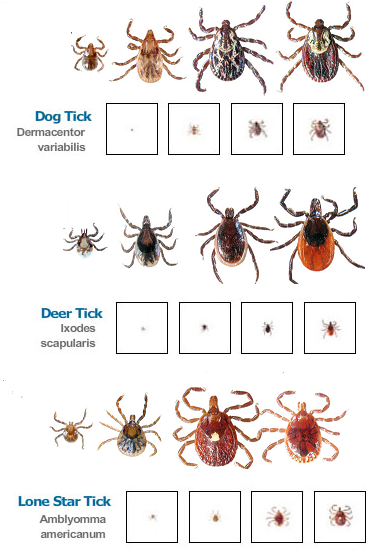Preventing Lyme Disease
By Geri Williams
 Most of us are spending more time outdoors, whether it is gardening (hopefully planting some native plants), walking or hiking or birding in our species rich watershed. Ticks are very common in our area. About 1 in 2 adult stage Deer or Blacklegged Ticks carry the bacterium that causes Lyme disease. They can also carry organisms that can cause babesiosis, anaplasmosis, and relapsing fever. About 1 in 4 nymph stage deer ticks carry Lyme disease. There are 2 other species of ticks common in our area: the American Dog tick and the Lone Star tick neither of which can cause Lyme disease, but can transmit other diseases. The nymph and adult stages of both these ticks are somewhat larger than the deer tick. Ticks can be identified for free through the University of Rhode Island’s TickSpotters service.
Most of us are spending more time outdoors, whether it is gardening (hopefully planting some native plants), walking or hiking or birding in our species rich watershed. Ticks are very common in our area. About 1 in 2 adult stage Deer or Blacklegged Ticks carry the bacterium that causes Lyme disease. They can also carry organisms that can cause babesiosis, anaplasmosis, and relapsing fever. About 1 in 4 nymph stage deer ticks carry Lyme disease. There are 2 other species of ticks common in our area: the American Dog tick and the Lone Star tick neither of which can cause Lyme disease, but can transmit other diseases. The nymph and adult stages of both these ticks are somewhat larger than the deer tick. Ticks can be identified for free through the University of Rhode Island’s TickSpotters service.
Deer ticks can be active all year long, but the nymph stage are active from early May through August. They are found mostly at ground level, and because of their tiny size they are hard to spot and pose the highest risk of causing Lyme disease. The adult deer ticks are most active from September through May. They can be found up to a couple of feet off the ground. Ticks cannot fly or jump. They rely on attaching to people or pets that brush up against them.
But that doesn’t mean we should avoid the woodsy outdoors. With some precautions we can enjoy hiking, walking and gardening activities while remaining safe. Deer ticks reside in shady, damp, brushy and wooded areas.
So after you have spent time in such an area be sure to do a tick check. If you wear light colored clothes and socks, ticks will be easier to spot.
Before going out use an insect repellent with at least 20% DEET, or 20% Picaridin, or 30% Oil of Eucalyptus on exposed skin. Permethrin is a product that is used only on fabrics. It does not provide repellency, but is very effective at preventing tick bites by killing ticks on contact. You can buy a spray bottle of permethrin by Sawyer to spray your shoes, socks and pants. You must spray the fabric ahead of time and let it dry. If you have a cat be careful not to let the cat near the clothing until it is completely dry, (it can be toxic if ingested by a cat). It remains active through 6 washings or for about a month. If you are an active hiker, you could plan to treat your shoes and clothing once a month. You can buy commercially treated clothing online through InsectShield.com, this protection lasts through 70 washings or about 1 year of regular use (~4-5 days of use per week).
If you do get bit by a tick you should remove it immediately, using pointy tweezers grasp it by the head as near to your skin as possible and pull straight up. (Do not use matches, petroleum jelly, gasoline or nail polish remover, etc.) If the mouthparts break off under your skin, they cannot continually transmit infection. Once the body of the tick is off, your risk of contracting Lyme and other diseases stops. After removing the tick apply antiseptic to the bite. Note the date and you can save the tick for identification and testing for which diseases it could transmit. Symptoms usually appear in 10-14 days. If you develop a rash, take a picture of it to show your physician. You should monitor your health closely after any tick bite, and should consult your physician if you experience a rash, fever, headache, joint or muscle pains, or swollen lymph nodes within 30 days of a tick bite. These can be signs of a number of tickborne diseases.
This article was written with information provided by Blake Dinius, the Plymouth County Entomologist. You can reach him at bdinius@plymouthcountyma.gov or 774-773-3404 if you need more information.

Comments
Preventing Lyme Disease — No Comments
HTML tags allowed in your comment: <a href="" title=""> <abbr title=""> <acronym title=""> <b> <blockquote cite=""> <cite> <code> <del datetime=""> <em> <i> <q cite=""> <s> <strike> <strong>